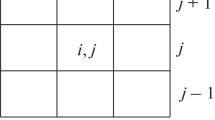Abstract—
The CABARET algorithm constructed earlier by the authors for calculating the motion of multicomponent gas mixtures is used for the numerical simulation of a physical instability evolving when a shock wave passes through an initially quiescent interface of gaseous media with different physical properties, which is followed by the turbulization of the flow in the planar geometry. The following two problems are simulated: the passage of a shock wave through a rectangular subdomain filled with a heavy gas and the development of a Richtmyer–Meshkov instability during the passage of a shock wave through a sinusoidal media interface. The obtained evolution of the width of the mixing zone is compared with the experimental, theoretical, and numerical results of other authors.








Similar content being viewed by others
REFERENCES
R. D. Richtmyer, “Taylor instability in shock acceleration of compressible fluids,” Commun. Pure Appl. Math. 13, 297–319 (1960).
E. E. Meshkov, “Instability of the interface of two gases accelerated by a shock wave,” Sov. Fluid Dyn., No. 4, 101–104 (1969).
K. A. Meyer and P. J. Blewett, “Numerical investigation of stability of a shock-accelerated interface between two fluids,” Phys. Fluids 15, 753–759 (1972).
Q. Zhang and S. I. Sohn, “Nonlinear theory of unstable fluid mixing driven by shock wave,” Phys. Fluids 9, 1106–1124 (1997).
O. Sadot, L. Erez, U. Alon, D. Oren, and L. A. Levin, “Study of nonlinear evolution of single-mode and two-bubble interaction under Richtmyer-Meshkov instability,” Phys. Rev. Lett. 80, 1654–1657 (1998).
G. C. Orlicz, S. Balasubramanian, and K. P. Prestridge, “Incident shock Mach number effects on Richtmyer-Meshkov mixing in a heavy gas layer,” Phys. Fluids, No. 25, 114101 (2013).
B. D. Collins and J. W. Jacobs, “PLIF flow visualization and measurements of the Richtmyer-Meshkov instability of an air/SF6 interface,” J. Fluid Mech. 464, 113–136 (2002).
B. E. Motl, “Experimental parameter study of the Richtmyer-Meshkov instability,” PhD Thesis (Univ. Wisconsin, Madison, 2008).
E. Leinov, G. Malamud, et al., “Experimental and numerical investigation of the Richtmyer-Meshkov instability under re-shock conditions,” J. Fluid Mech. 626, 449–475 (2009).
J.-F. Haas and B. Sturtevant, “Interaction of weak shock waves with cylindrical and spherical gas inhomogeneities,” J. Fluid Mech. 181, 41–76 (1987).
D. A. Holder et al., “Shock-tube experiments on Richtmyer-Meshkov instability growth using an enlarged double bump perturbation,” Laser Part. Beams 21, 411–418 (2003).
R. Abgrall, “How to prevent pressure oscillations in multicomponent flow calculations: a quasi conservative approach,” J. Comput. Phys. 125, 150–160 (1996).
M. Latini, O. Schiling, and W. S. Don, “High-resolution simulations and modeling of reshocked single-mode Richtmyer-Meshkov instability: comparison to experimental data and to amplitude growth model predictions,” Phys. Fluids 19, 024104 (2007).
M. Latini, O. Schiling, and W. S. Don, “Effects of WENO flux reconstruction order and spatial resolution on reshocked two-dimensional Richtmyer-Meshkov instability,” J. Comput. Phys. 221, 805–36 (2007).
V. F. Tishkin, V. V. Nikishin, I. V. Panov, and A. P. Favorskii, “Finite difference schemes of three-dimensional gas dynamics for the study of Richtmyer–Meshkov instability,” Mat. Model. 7 (5), 15–25 (1995).
P. Movahed and E. Johnsen, “Numerical simulations of the Richtmyer-Meshkov instability with reshock,” in Proceedings of the 20th AIAA Computational Fluid Dynamics Conference, Honolulu, 2011.
P. Movahed and E. Johnsen, “A solution-adaptive method for efficient compressible multifluid simulations, with application to the Richtmyer-Meshkov instability,” J. Comput. Phys. 239, 166–186 (2013).
V. K. Tritschler, X. Y. Hu, S. Hickel, and N. A. Adams, “Numerical simulation of a Richtmyer-Meshkov instability with an adaptive central-upwind sixth-order WENO scheme,” Phys. Scr. 155, 014016 (2013).
S. Ukai, K. Balakrishnan, and S. Menon, “Growth rate predictions of single- and multi-mode Richtmyer-Meshkov instability with reshock,” Shock Waves 21, 533–546 (2011).
A. Yosef-Hai, O. Sadot, et al., “Late-time growth of the Richtmyer-Meshkov instability for different Atwood numbers and different dimensionalities,” Laser Part. Beams 21, 363–368 (2003).
J. T. Morán-López, “Multicomponent Reynolds-averaged Navier-Stokes modeling of reshocked Richtmyer-Meshkov instability-induced turbulent mixing using the weighted essentially nonoscillatory method,” PhD Thesis (Univ. of Michigan, Ann Arbor, 2013).
K. R. Bates, N. Nikiforakis, and D. Holder, “Richtmyer-Meshkov instability induced by the interaction of a shock wave with a rectangular block of SF6,” Phys. Fluids 19, 036101 (2007).
R. S. Lagumbay, “Modeling and simulation of multiphase/multicomponent flows,” PhD Thesis (Univ. of Colorado, Boulder, 2006).
V. M. Goloviznin and A. A. Samarskii, “Finite difference approximation of convective transport equation with space splitting time derivative,” Mat. Model. 10 (1), 86–100 (1998).
V. M. Goloviznin and A. A. Samarskii, “Some characteristics of finite difference scheme cabaret,” Mat. Model. 10 (1), 101–116 (1998).
V. M. Goloviznin and S. A. Karabasov, “Nonlinear correction of Cabaret scheme,” Mat. Model. 10 (12), 107–123 (1998).
V. M. Goloviznin, S. A. Karabasov, and I. M. Kobrinskii, “Balance-characteristic schemes with separated conservative and flux variables,” Mat. Model. 15 (9), 29–48 (2003).
V. M. Goloviznin, “Balanced characteristic method for 1D systems of hyperbolic conservation laws in eulerian representation,” Mat. Model. 18 (11), 14–30 (2006).
V. M. Goloviznin, V. N. Semenov, I. A. Korotkin, and S. A. Karabasov, “A novel computational method for modelling stochastic advection in heterogeneous media,” Transp. Porous Media 66, 439–456 (2007).
A. V. Danilin and A. V. Solov’ev, “A modification of the CABARET scheme for the computation of multicomponent gaseous flows,” Vychisl. Metody Programmir. 16, 18–25 (2015).
A. V. Danilin, A. V. Solov’ev, and A. M. Zaitsev, “A modification of the CABARET scheme for numerical simulation of multicomponent gaseous flows in two-dimensional domains,” Vychisl. Metody Programmir. 16, 436–445 (2015).
Author information
Authors and Affiliations
Corresponding authors
Additional information
Translated by I. Pertsovskaya
Rights and permissions
About this article
Cite this article
Danilin, A.V., Solovjev, A.V. Simulation of Turbulent Mixing by the CABARET Algorithm for the Case of a Richtmyer–Meshkov Instability. Math Models Comput Simul 11, 247–255 (2019). https://doi.org/10.1134/S2070048219020054
Received:
Accepted:
Published:
Issue Date:
DOI: https://doi.org/10.1134/S2070048219020054




